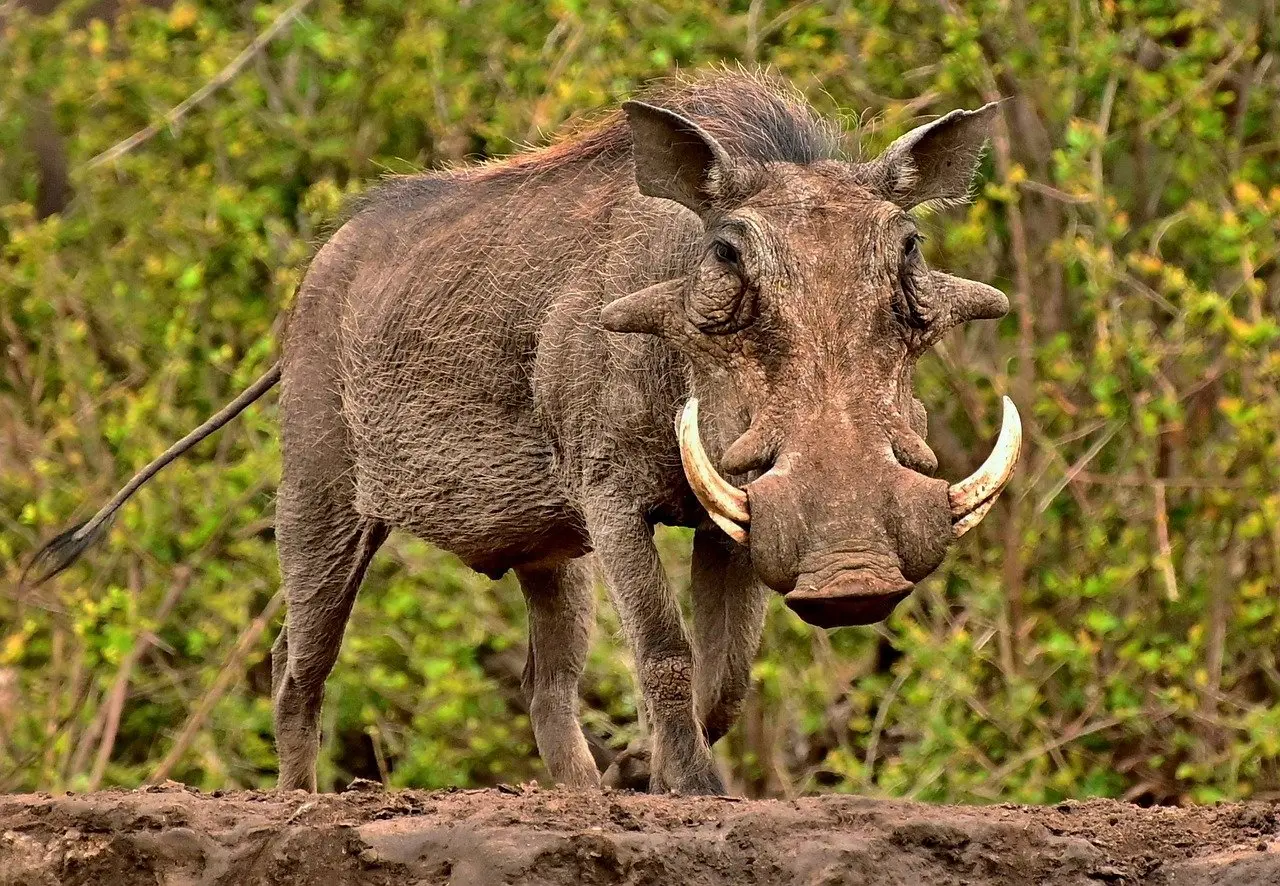The warthog (scientific name: Phacochoerus africanus) is a wild member of the pig family found in Africa. It is known for its distinctive appearance and behaviour, which sets it apart from other animals. Here’s a detailed background and the characteristics that distinguish the warthog from other species:
Background:
1. Habitat and Range:
Warthogs are native to the grasslands, savannas, and open woodlands of sub-Saharan Africa. They prefer habitats that offer both open areas for grazing and cover for hiding, such as shrublands and woodlands. They are also commonly found near water sources, as they often use mud to cool down.
2. Physical Appearance:
Warthogs are medium-sized mammals with a rugged appearance, characterised by their large heads, flat snouts, and prominent tusks. Adult warthogs weigh between 120 to 250 pounds and stand about 30 inches at the shoulder.
They have sparse hair covering their bodies, except for a mane running down their spines, and a tuft of hair on their tail tips. Their skin is thick and dark greyish-brown.
One of their most striking features is the pair of large, curved tusks that protrude from their mouths. These tusks are actually elongated canine teeth, with the upper pair curving upwards.
3. Diet:
Warthogs are omnivores but primarily graze on grasses, roots, berries, and tubers. They also eat small animals, insects, and carrion when food is scarce.
They have a unique feeding behaviour, often kneeling on their forelegs to dig up roots and bulbs, and using their snouts to plough through the soil.
4. Social Structure:
Warthogs are social animals that live in groups called “sounders,” usually consisting of females and their young. Males tend to be solitary or form small bachelor groups.
They are highly territorial, using scent markings from glands near their tusks and on their faces to mark their territories.
Despite their fearsome appearance, warthogs prefer flight over fight when threatened, seeking safety in burrows, which they often back into so that their tusks face outward toward potential predators.
5. Reproduction:
Female warthogs (sows) give birth to litters of 2 to 8 piglets after a gestation period of around 5 to 6 months. Piglets are usually born in burrows, where they stay for protection until they are strong enough to follow their mothers.
Distinguishing Characteristics of a Warthog:
1. Tusk Formation:
Warthogs have two pairs of tusks: the upper tusks are larger and more prominent, curving outward and upward, while the lower tusks are shorter and sharper, functioning as cutting tools.
These tusks are primarily used for self-defence against predators, such as lions and leopards, and during fights with other warthogs.
2. Facial Warts:
Warthogs are named for the fleshy warts or lumps that appear on their faces. These are not true warts but thick pads of skin, which protect them during fights or from predator attacks.
Males have larger and more pronounced warts than females, which is one of the easiest ways to distinguish between the sexes.
3. Adaptation to Burrowing:
Unlike other pig species, warthogs are skilled at using abandoned burrows (usually made by aardvarks) for shelter. They back into these burrows to defend themselves from predators, exposing only their tusks.
They also use these burrows for resting during the hot midday sun, as warthogs are not well-adapted to extreme heat.
4. Kneeling Grazing Behaviour:
One of the warthog’s unique feeding behaviours is their habit of kneeling on their calloused front knees while foraging. This is an adaptation that allows them to root in the ground for food without wearing down their hooves.
5. Speed and Agility:
Despite their bulky appearance, warthogs are remarkably fast runners. They can reach speeds of up to 30 miles per hour, allowing them to escape from predators quickly.
They raise their thin, tufted tails straight up in the air when they run, a signal that may help keep sounders together while fleeing.
6. Temperament:
Although they generally avoid confrontation, warthogs can be aggressive when cornered or defending their young. They will charge at predators or perceived threats, using their sharp tusks as weapons.
7. Resilience and Intelligence:
Warthogs are known for their resilience and ability to survive in harsh environments. They can go without water for extended periods and have the ability to withstand extreme droughts by relying on moisture from the plants they consume.
They are also intelligent animals that have been observed using strategies to outwit predators, such as hiding in burrows or tricking predators into chasing them in circles.
Conclusion:
The Warthog is a fascinating animal, easily recognisable by its tusks, facial warts, and unusual grazing posture. Its ability to adapt to a wide variety of environments, combined with its physical defences, makes it a highly successful species in the wild. Warthogs stand out from other animals not only because of their appearance but also their behavioural adaptations and survival strategies.





